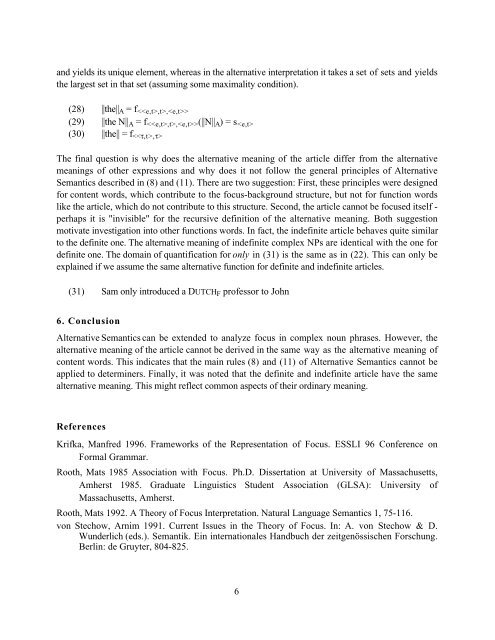Focus in complex noun phrases
Focus in complex noun phrases
Focus in complex noun phrases
Create successful ePaper yourself
Turn your PDF publications into a flip-book with our unique Google optimized e-Paper software.
and yields its unique element, whereas <strong>in</strong> the alternative <strong>in</strong>terpretation it takes a set of sets and yields<br />
the largest set <strong>in</strong> that set (assum<strong>in</strong>g some maximality condition).<br />
(28) ||the|| A = f ,><br />
(29) ||the N|| A = f ,> (||N|| A ) = s <br />
(30) ||the|| = f <br />
The f<strong>in</strong>al question is why does the alternative mean<strong>in</strong>g of the article differ from the alternative<br />
mean<strong>in</strong>gs of other expressions and why does it not follow the general pr<strong>in</strong>ciples of Alternative<br />
Semantics described <strong>in</strong> (8) and (11). There are two suggestion: First, these pr<strong>in</strong>ciples were designed<br />
for content words, which contribute to the focus-background structure, but not for function words<br />
like the article, which do not contribute to this structure. Second, the article cannot be focused itself -<br />
perhaps it is "<strong>in</strong>visible" for the recursive def<strong>in</strong>ition of the alternative mean<strong>in</strong>g. Both suggestion<br />
motivate <strong>in</strong>vestigation <strong>in</strong>to other functions words. In fact, the <strong>in</strong>def<strong>in</strong>ite article behaves quite similar<br />
to the def<strong>in</strong>ite one. The alternative mean<strong>in</strong>g of <strong>in</strong>def<strong>in</strong>ite <strong>complex</strong> NPs are identical with the one for<br />
def<strong>in</strong>ite one. The doma<strong>in</strong> of quantification for only <strong>in</strong> (31) is the same as <strong>in</strong> (22). This can only be<br />
expla<strong>in</strong>ed if we assume the same alternative function for def<strong>in</strong>ite and <strong>in</strong>def<strong>in</strong>ite articles.<br />
(31) Sam only <strong>in</strong>troduced a DUTCH F professor to John<br />
6. Conclusion<br />
Alternative Semantics can be extended to analyze focus <strong>in</strong> <strong>complex</strong> <strong>noun</strong> <strong>phrases</strong>. However, the<br />
alternative mean<strong>in</strong>g of the article cannot be derived <strong>in</strong> the same way as the alternative mean<strong>in</strong>g of<br />
content words. This <strong>in</strong>dicates that the ma<strong>in</strong> rules (8) and (11) of Alternative Semantics cannot be<br />
applied to determ<strong>in</strong>ers. F<strong>in</strong>ally, it was noted that the def<strong>in</strong>ite and <strong>in</strong>def<strong>in</strong>ite article have the same<br />
alternative mean<strong>in</strong>g. This might reflect common aspects of their ord<strong>in</strong>ary mean<strong>in</strong>g.<br />
References<br />
Krifka, Manfred 1996. Frameworks of the Representation of <strong>Focus</strong>. ESSLI 96 Conference on<br />
Formal Grammar.<br />
Rooth, Mats 1985 Association with <strong>Focus</strong>. Ph.D. Dissertation at University of Massachusetts,<br />
Amherst 1985. Graduate L<strong>in</strong>guistics Student Association (GLSA): University of<br />
Massachusetts, Amherst.<br />
Rooth, Mats 1992. A Theory of <strong>Focus</strong> Interpretation. Natural Language Semantics 1, 75-116.<br />
von Stechow, Arnim 1991. Current Issues <strong>in</strong> the Theory of <strong>Focus</strong>. In: A. von Stechow & D.<br />
Wunderlich (eds.). Semantik. E<strong>in</strong> <strong>in</strong>ternationales Handbuch der zeitgenössischen Forschung.<br />
Berl<strong>in</strong>: de Gruyter, 804-825.<br />
6
















